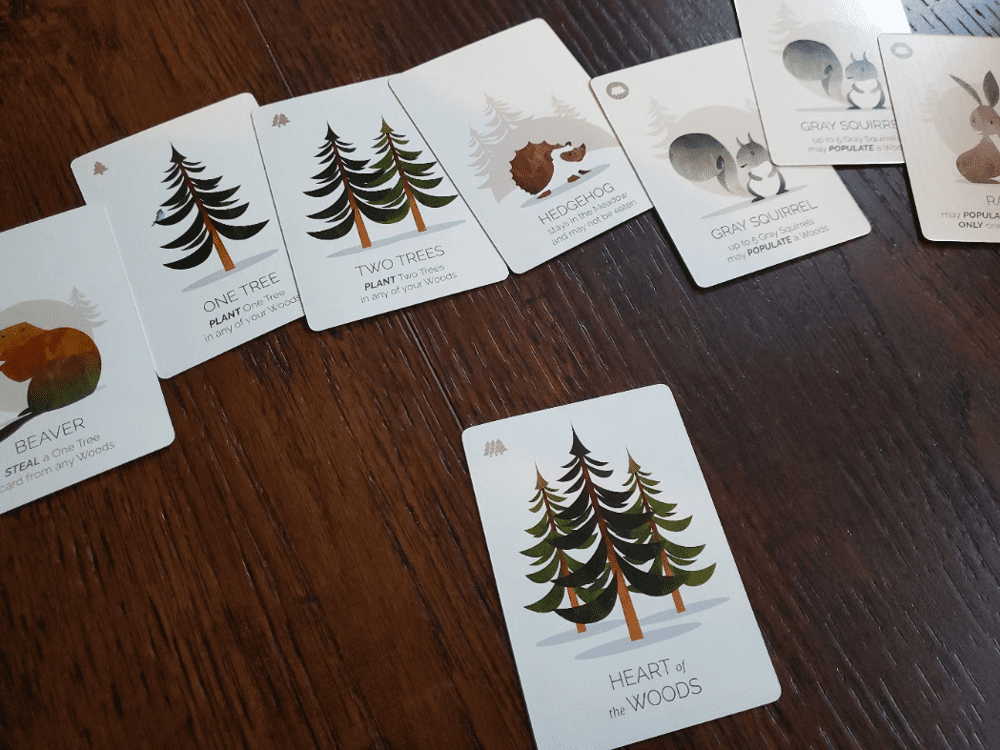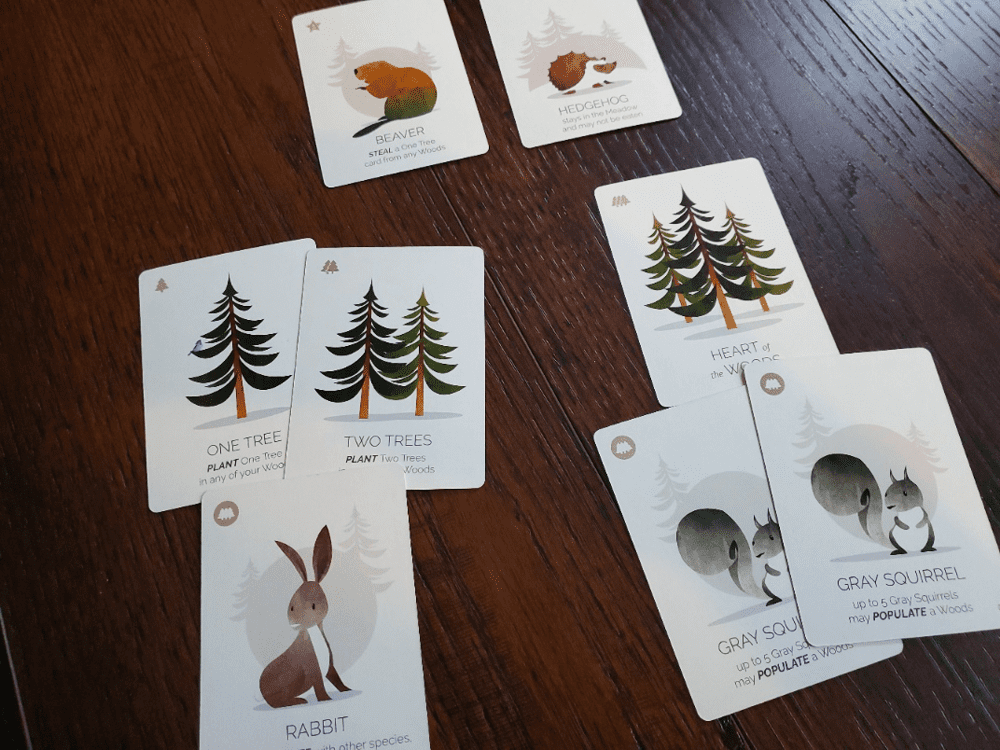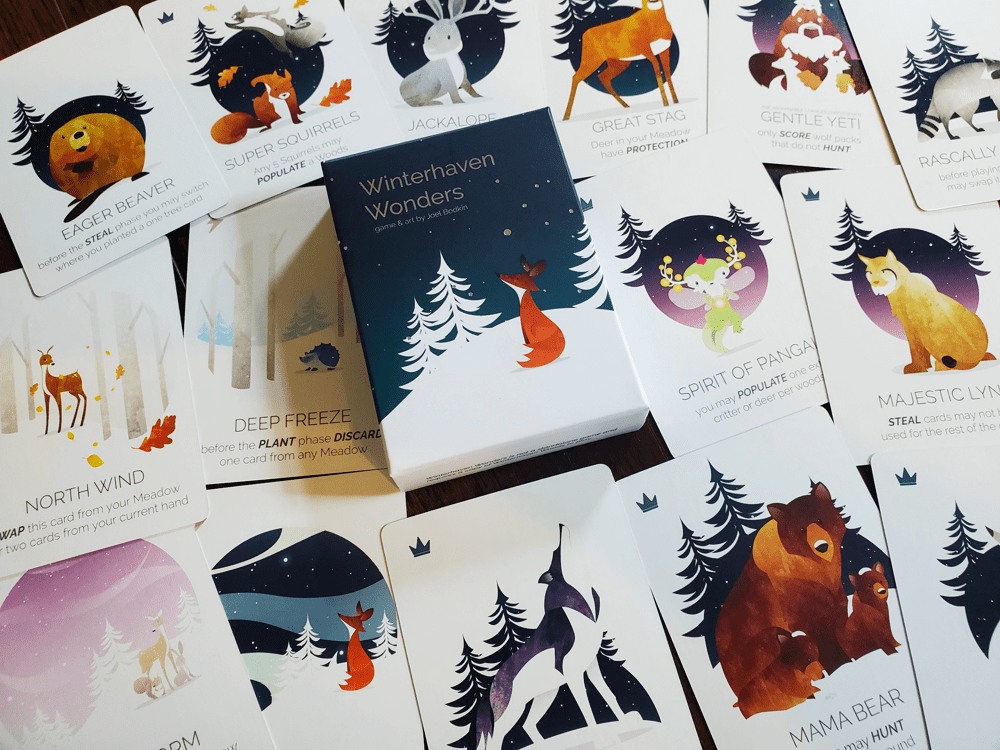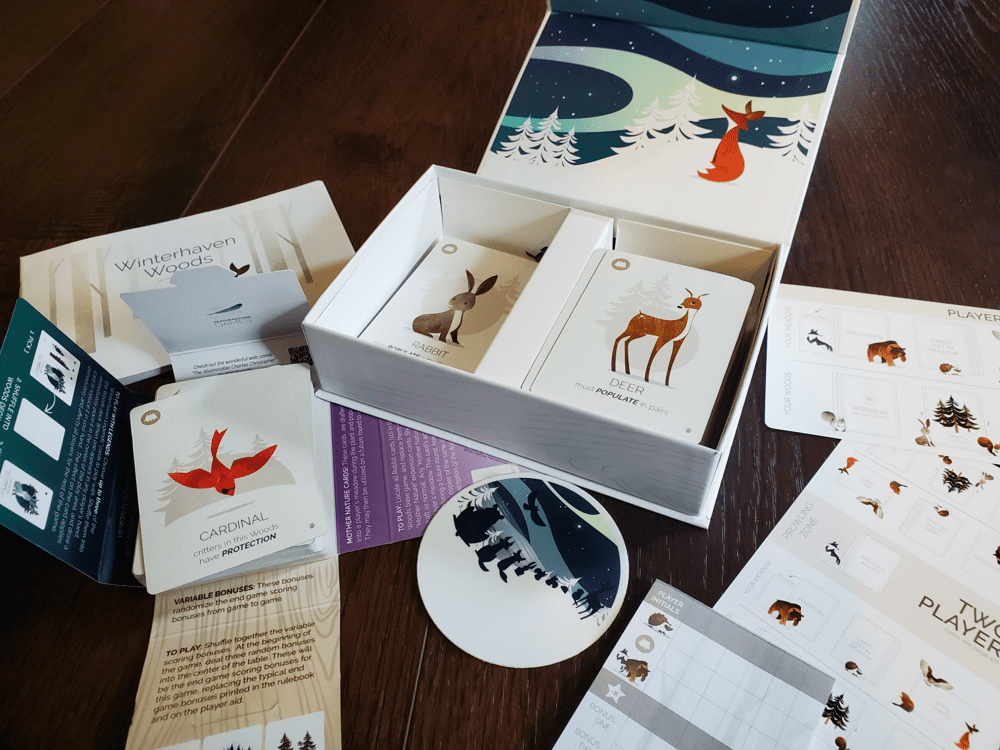Here at Meeple Mountain, we are fond of step ladders—a collection of games that introduce and build on core concepts to prepare players to ascend the ranks of complexity and depth in the hobby. Step ladders are a marvelous idea for welcoming new gamers or simply enjoying a favorite mechanic in a variety of expressions.
Sometimes, a game is a step ladder of an unexpected variety.
Winterhaven Woods is the second offering from designer Joel Bodkin (Open Oceans) and his self-publishing enterprise, Featherstone Games. Joel is an industry unto himself as the designer, artist, developer, and publisher of his titles. Winterhaven Woods successfully funded on Kickstarter in summer 2021 and reached backers earlier this calendar year. It is in many regards a typical card drafting game.
What makes these Woods so interesting is that Joel designed this cute and cuddly critter game to loosely teach his son the concept of booster drafting in Magic: The Gathering. Booster drafting is a style of play in which folks each purchase a few booster packs of a living card game like MTG and open them simultaneously into a draft to build playable decks from the unknown pool. I’m not a Magic guy, but if I played, I think I would most enjoy this method primarily because it equalizes the Bruce Wayne/Tony Stark superpower that dominates every such card game—the winner is the one with the most real-life money to buy the good cards.
Winterhaven Woods is most definitely not Magic: The Gathering. And while blind booster draft is somewhat mimicked in the gameplay, the game itself is a wholly different species. But the fascinating backstory, interesting mechanics, and gorgeous artwork drew me in. I was happy to find that the game inside is interesting too.
Woods and Meadows
In Winterhaven Woods, players are each managing their meadow and watching their woods to help the critters hunker down for the winter. The object is to plant sufficient tree cover and welcome the peaceful critters while withstanding thieves and predators; and to do it better than everyone else at the table.
All of this happens via card drafting. The base game consists of 126 cards—a sizeable deck! Each player receives one Heart of the Woods card to start their woodland resort and a hand of 6-10 cards depending on the player count.
The game takes place over three rounds (except in a 2-player game, but I’ll talk about that below). Players draft cards face-down one at a time into their Meadow—the upper row of cards nearest the center of the table—before passing their hands along to the next player. Cards may be trees, peaceful critters, thieving critters, or predators. This secret draft continues until all the cards are selected, at which point players reveal the take in one grand moment.

Tree cards can then be planted into the Woods. Woods are considered ready for population once they contain three trees. Each player may have three active woods in front of them during the game, and each wood may contain animals equal to the number of trees.
Once the trees are in place, players populate the woods with critters. Each animal must be placed according to its conditions: deer must arrive in pairs, squirrels separate by color into groups as high as five, rabbits can join any wood, but only one per (because two rabbits would soon be a more populous problem!). With the exception of rabbits, each wood can only have one critter type, meaning there are typically animals stuck in the meadow each round who would rather be in the protection of the wood. Sadly, they then face the prospect of theft and mortal peril.
Other animals remain in the meadow by design: Hedgehogs because they live there fearlessly and score easy points at the game’s end. Thieves acquired that round stay long enough to do their crafty work before being discarded. Predators live there as well, doing their best to eat from the surrounding meadows.

As far as thieves are concerned: Foxes steal critters away from a meadow. Owls go deeper, stealing critters from the wood. The mutant super-Beavers steal trees—whole trees!—from other players. Each thief card is marked with a number that dictates the order of thievery. Stealing is always optional, but there is an increasing penalty the more you engage the dirty work.
Finally, Predators are permitted to hunt animals in the meadows. Wolves who have formed a pack of three or more go first, followed by the bears. Again, the pecking order is determined by the lowest numbers on the cards. Each predatory unit can eat once per round, taking away a critter who would potentially score points in the woods later. Wolves need only eat once in the game, but bears have no choice but to hunt in each round. Predators must finish the final round in a satisfied state (the card being rotated 90° after having eaten) in order to score.

The game continues in this fashion for a few rounds and then woods & meadows are scored according to their surviving species. Populated woods score one point per safe animal. Hedgehogs score a point each as well from the meadow. Satisfied predators are one point each, plus a point per kill. Excess thievery is penalized and then end game bonuses are calculated.
Four bonuses are included in the base game and come from conditions like the largest deer population, achieving three separate ready woods, eating three different types of creatures, and collecting like-colored birds in the trees.
The high score wins—plain and simple.
Fearing the wolves
One challenge in any drafting game is the two-player iteration. Passing the same cards back and forth works, but information glut creates a different sort of tension that can go stale. Thankfully, Winterhaven Woods has a unique two-player setup that adds a hint of the unexpected to color the two-player affair.
Wolves become a separate entity, occupying a shared center Prowling Zone. Any dealt wolves are immediately played into the Zone to form packs that will hunt from the meadows of both players before being discarded. There are enough wolves in the deck to make this feel at times like you’re preparing a buffet for them, but this is a nice offset to the freedom that often comes from a lack of competition on the table. With five rounds instead of three, the two-player game has an interesting flow that attempts to dig into the deck more completely.
Shaking it up
The Kickstarter funded a triple expansion pack that introduces a load of variety at different stages of the game. Winterhaven Legends are single cards that join the deck (three per game) to alter the way the various species function. If a Legend is dealt, it is revealed for the whole table and then replaced in the draft with a new card. Without warning, squirrels then might start ignoring colors, rabbits might start mixing with each other, and wolves may all of a sudden go vegetarian. Because the whole deck is never quite used, these Legends might show, they might not. The possibility builds anticipation, and the eventual arrival raises a stir of shifting strategies.
Mother Nature expansion cards can join the draft as well. The Aurora Borealis cards add a set to be collected for incremental points. The Snowstorm can protect your meadow for a round, while the Deep Freeze can harm your woods by discarding a critter. These cards add volatility to the game and the scorecard.
Variable Bonus cards introduce a handful of extra end game conditions to pursue so that each game can feature a different set and a different overall flavor.

The eye of the beholder
Opening Winterhaven Woods has been one of the finer board game treats of my year so far. Unboxing is always fun, but unboxing a stunner is downright joyful. The magnet-clasp box is beautiful for its use of white space to highlight the marvelous critters. The inside flap adds the borealis for a lovely welcome. Everything inside this package is pretty, from the elegant cards to the clever folded box that wraps the expansion. The accompanying stickers are no slouch. I cannot complain about the aesthetics.
Because everything was handled in-house by Joel and his Featherstone family, I must at least acknowledge that this game was a rare picture of timely efficiency for a Kickstarter campaign in the pandemic era. July funding. January delivery as promised. I love when a project builds and maintains its momentum right to the table.
As a teacher for booster drafting, I see what Joel was up to. Many simple drafting games involve constant reveals and an ever-evolving understanding of what is happening around the table. Winterhaven Woods celebrates only three drastic reveals that keep each round distinct. The landscape can change in so many ways with each passing round—new woods, new critters, new predators, fresh tactics. In MTG, a booster draft is designed to restrict players with partial information until the interaction starts, with only a very limited knowledge of the available cards other players are keeping. These Woods accomplish that aim in micro form. Even the spending of a predator or a thief, rotating it 90° to show that it has been used, says that the Woods were designed by someone familiar with living card games.

The big reveals feed the interactive moments in each round. I am not a huge fan of take-that mechanics, so I appreciate that theft here is both available and discouraged. Everyone gets a free steal before being penalized, meaning friendly tension rarely turns into rampant vindictive burglary. That doesn’t mean theft can’t change the game, though. Stealing away the third tree from a wood makes the trees uninhabitable, booting the critters back to the meadow and possibly to hungry predators. Stealing a deer from its partner likewise evicts the remaining single to the dangerous meadow. These moments are significant—and fun.
The Hunting phase mostly serves as a meadow-clearing from round to round. Meadow creatures are yum-yums for the carnivores, and there’s little to be done about it. The real question is whether everyone’s predators will have the opportunity to eat and score. Effective woodland management can protect critters and leave beasts hungry, forcing later desperate maneuvers. One of the more interesting design decisions is to allow a predator to eat from their home meadow! Is there no loyalty?!
Our first couple plays were awkward because Winterhaven Woods is not quite like the other drafting games in our repertoire. The booster-style draft, the split meadow/wood dynamic, the ever-shifting contingencies in maintaining the trees, the various end game bonuses all served to add a hint of confusion. With each successive play, though, I began to see more of the nuance in the mechanics. At 20 minutes per play, the learning curve is fast enough.
Some drafting games allow players the freedom to ignore. 7 Wonders, for example, can be a military fun-fest, but it can just as easily play without an eye toward the military at all. Likewise, Sushi Go Party may speak of Maki, but with so many items on the menu, the game never hinges on one dish or another.
Winterhaven Woods is a refreshing change because it seems to require a little bit of everything in order to thrive. Once the rules click, you realize you need multiple hospitable woods, you need animals to populate, you need hedgehogs mulling about the Meadow, you need a predator or two keeping things even, and you probably need to steal something at some point in order to glue it all together. Though it is simple in many ways, it requires a full view and a keen sense of timing for mastery, and I appreciate that—especially when it’s so very pretty on the table.
Best of all? It’s not really that expensive. It’s a fun little risk, one that seems to have settled into a cozy spot on our shelf.












Add Comment